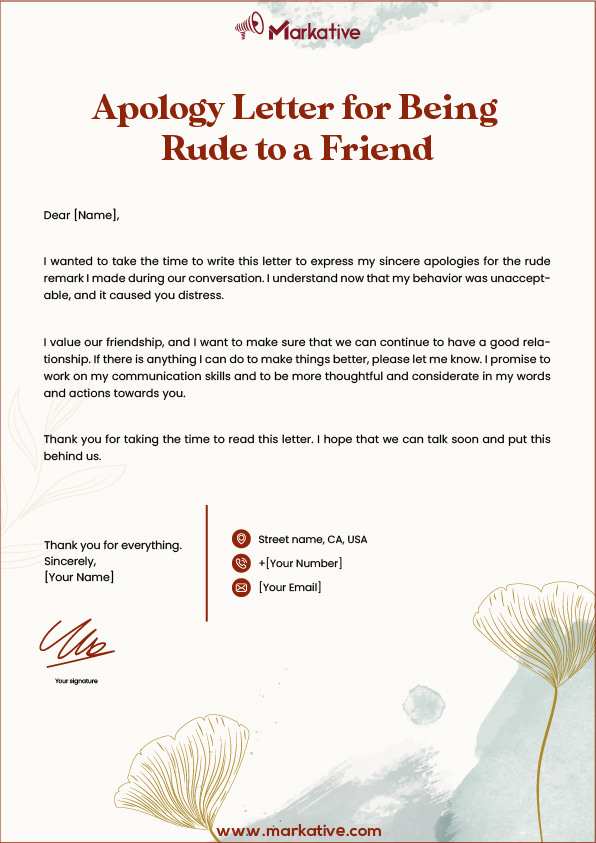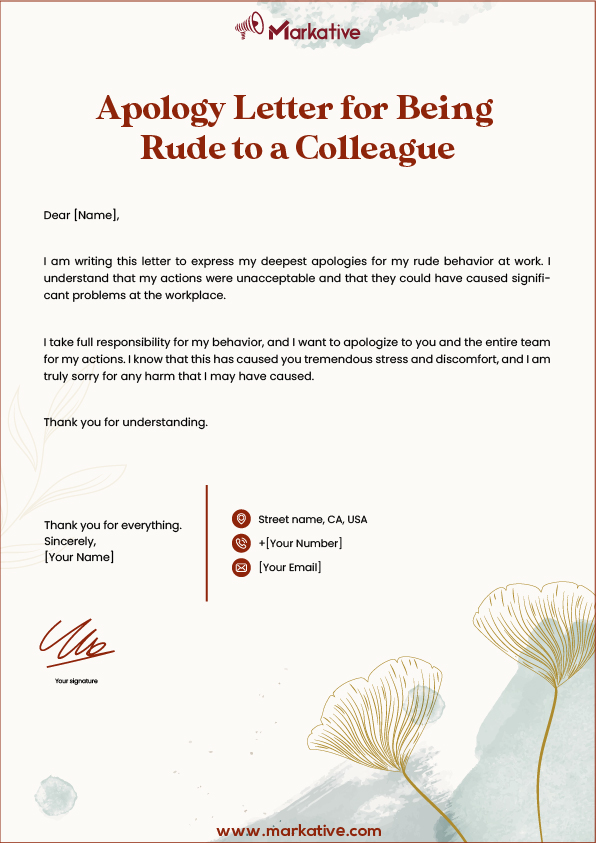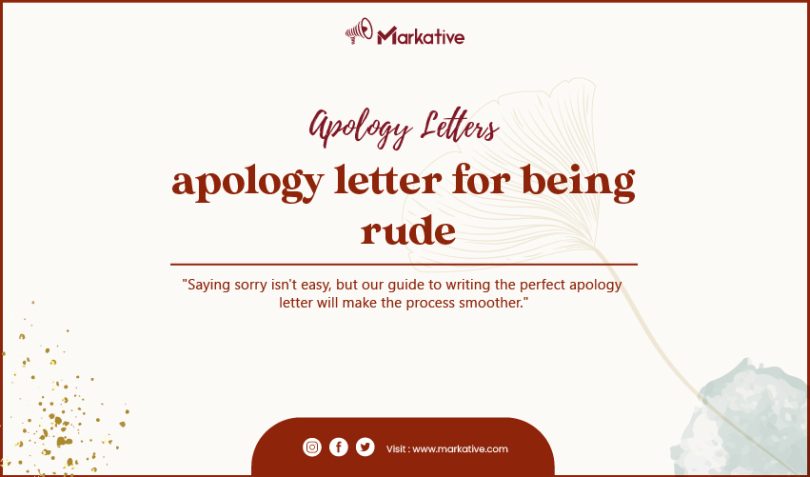In life, we all make mistakes and can end up speaking or behaving in a rude way to others. While sometimes apologies can be made in person, other times, it may be necessary to write a formal apology letter to express remorse and ask for forgiveness.
Writing a letter can be a difficult task, especially when you are apologizing for being rude. However, with a little guidance and helpful tips, the process can be made easier. This article will provide you with a comprehensive guide to writing an apology letter for being rude and 7 ready samples to help you get started.
Why write an Apology Letter for Being Rude?
Writing an apology letter is one of the most effective and highly regarded ways of expressing a sincere apology. Apology letters show that you took time and effort to think seriously about the situation, take responsibility for your actions and seek forgiveness. They can also help to rebuild trust and demonstrate your commitment to making amends with the other person. Apology letters are essential for several scenarios, including:
- Sending to a boss or colleague for being rude at work
- Sending to a friend, family member, or partner that you’ve been rude to
- Sending to a teacher or someone in higher authority for being rude or disrespectful
- Sending to a customer, client, or colleague for a rude email, phone call, or altercation

Tips for Writing an Apology Letter for Being Rude
When writing an apology letter for being rude, it’s important to be sincere and use the right tone to convey your message effectively. Here are some tips to help you:
1. Start with a sincere apology: Begin your letter by expressing your apologies for your behavior and any hurtful words that you may have said. Acknowledge that your actions were inappropriate, and you understand your actions have caused hurt and offense to the other person.
2. Take responsibility for your actions: Don’t try to justify your rude comments or make excuses for your behavior. Instead, take full responsibility and accountability for your actions. Acknowledge what you did and the impact of it on the other person.
3. Explain your intentions: It may be helpful to explain why you behaved in a rude way. However, this should not sound like an excuse. Provide a valid reason for your actions and explain your intentions, demonstrating that you regret your behavior.
4. Show empathy: Demonstrate empathy and understanding for the other person’s feelings and situation. Acknowledge their perspective and offer to make amends where possible.
5. Offer a course of action In your letter, offer a course of action. This could include an invitation to discuss the matter further, a suggestion that you work on your communication skills, or an offer to rectify any issues that have arisen from your behavior.
6. End on a positive note: Finish your letter by expressing your sincere hope to restore the relationship and rebuild trust. Sign off with a positive remark and reiterate your apology.
For More: Professional Apology Letter: 7 Ready Samples
7 Ready Samples of Apology Letters
Here are seven ready-to-use apology letter templates you can use for inspiration or modify to fit your specific situation:
Apology Letter for Being Rude to a Friend
Dear [Name], I wanted to take the time to write this letter to express my sincere apologies for the rude remark I made during our conversation. I understand now that my behavior was unacceptable, and it caused you distress. I am sorry for the offensive comment I made and how it affected your feelings. I know I was wrong to speak the way I did, and I take full responsibility for my actions. Please accept my sincere apologies and know that I am committed to making things right. I value our friendship, and I want to make sure that we can continue to have a good relationship. If there is anything I can do to make things better, please let me know. I promise to work on my communication skills and to be more thoughtful and considerate in my words and actions towards you. Thank you for taking the time to read this letter. I hope that we can talk soon and put this behind us. Sincerely, [Your Name]
For More: Unique Apology Letter for Cheating: 7 Ready Samples
Apology Letter for Being Rude to a Colleague
Dear [Name], I am writing this letter to express my deepest apologies for my rude behavior at work. I understand that my actions were unacceptable and that they could have caused significant problems at the workplace. I take full responsibility for my behavior, and I want to apologize to you and the entire team for my actions. I know that this has caused you tremendous stress and discomfort, and I am truly sorry for any harm that I may have caused. I hope that you can accept my apologies and that we can move forward from this. I am committed to working on my communication skills and ensuring that my behavior does not cause any issues in the future. Please let me know if there is anything that I can do to make this better, and I promise to do everything to make it right. Thank you for understanding. Sincerely, [Your Name]
For More: Attractive Behavior Apology Letter: 9 Ready Samples
Apology Letter for Being Rude to a Parent
Dear [Name], I want to express my deepest apologies for my rude behavior towards you. I understand now that my behavior was unacceptable, and I have no excuse for it. I know that what I did must have hurt you deeply, and I am genuinely sorry for any pain or discomfort that I have caused. I realize that the way I behaved was entirely inappropriate and disrespectful. I hope you can find it in your heart to forgive me for my actions. Please know that I respect and love you, and I never meant to cause you any harm. I want to promise that I will change my ways and work hard to earn your trust and respect. I value our relationship and will do everything in my power to ensure that nothing like this ever happens again. Sincerely, [Your Name]
Apology Letter for Being Rude to a Teacher
Dear [Name], I wanted to take a moment to apologize for my rude behavior in your class. I understand that my actions were not only inappropriate but disrespectful to you. As a teacher, you deserve nothing but the best treatment, and I failed to give you the basic courtesy you deserved. I want to express my deepest apologies for any distress my behavior has caused you and the class. I also want to take this opportunity to assure you that it will never happen again. I appreciate everything you have done for me, and I value the education that you are providing me. I recognize that my actions were wrong, and I want to make this right. I promise to work on changing my behavior and assure you that nothing like this will ever happen again. Sincerely, [Your Name]
For More: Best Apology Letter for Disrespectful Behavior to Parents: 7 Ready Samples
Apology Letter for Being Rude to a Customer
Dear [Name], I am writing this letter to apologize for the offense that I caused during our recent interaction. My behavior was entirely inappropriate, and I understand that it must have caused significant inconvenience and discomfort. I take full responsibility for my rude comments and understand that they may have caused harm to your reputation or business. I also realize now that they reflected poorly on the company that I work for, and I am embarrassed for that. I want you to know that I am committed to making things right. I promise to work on my communication skills, respect your position, and handle any concerns that you may have with utmost care. Please accept my apologies, and I hope that we can move forward positively. Sincerely, [Your Name]
For More: Best Write a Apology Letter for Disrespectful Behavior with [7 Samples]
Apology Letter for Being Rude to a Partner
Dear [Name], I am writing this letter to express my deepest apologies for the rude comments I made during our recent argument. My words were out of line, and I know that they caused hurt and discomfort to you. I understand that my behavior was completely unacceptable, and I take full responsibility for my actions. I am so sorry for the way I spoke and the pain I caused. You mean everything to me, and I would never want to hurt you intentionally. I want to make things right between us and assure you that I will work on being more thoughtful and respectful in my words and actions towards you. I hope that we can move past this and continue to build our relationship together. If there is anything that I can do to make things better, please let me know. I value our relationship deeply, and I will do everything in my power to make sure that nothing like this ever happens again. Sincerely, [Your Name]
Apology Letter for Being Rude to a Higher Authority
Dear [Name], I am writing this letter to express my deepest apologies for my rude behavior during our recent meeting. I know that my behavior was inappropriate, and disrespectful to someone in your position. I take full responsibility for my actions, and I am truly sorry for any harm or offense caused. I understand that your position demands nothing but the utmost respect, and I failed to give that on my part. I am committed to working harder to give the respect that is appropriate for someone in your position. Please let me know if there is anything that I can do to make amends or if there is anything that I can do to avoid this situation happening again in the future. I hope you can accept my sincere apologies, and I thank you for your understanding. Sincerely, [Your Name]

Steps to writing an Apology Letter for Being Rude
Now that we have covered some general tips, here’s a step-by-step process to write an apology letter for being rude.
1. Address your letter: Begin by addressing the person you are apologizing to. Address your letter using their name and use the correct title if necessary. You could also add a formal greeting such as “Dear [Name]” or “Respected [Name]”.
2. Start with a sincere apology: Start your letter by expressing your apologies and acknowledging that you were rude and your actions were inappropriate. Use the correct words and express that you are genuinely sorry for your behavior.
3. Take responsibility: Own up to your actions. Avoid blaming anyone else or making excuses. Take full responsibility for your actions and acknowledge how they hurt the other person.
4. Clarify the situation: Clarify the situations that led you to behave rudely. Explain any reasons behind your actions. This will show the other person that you are considering how they may be feeling.
5. Express your empathy: Show empathy and understand the other person’s situation. You can describe how you would feel if you were in their situation and assure them you don’t like how you behaved towards them.
6. Offer a course of action: Offer a course of action to repair the damage from your rude behavior. Let the other person know that steps have been taken to avoid the same situation from happening again.
7. End positively: Apologize again at the end of your letter and let the other person know you appreciate their attention. Close the letter with a neutral or positive note, leaving the door open for future communication.
For More: Explanation Letter for Mistake at Work: 7 Ready Samples
Key Takeaways
Writing an apology letter for being rude can be a difficult task, but it’s essential to take responsibility for your actions and seek forgiveness. The tips and samples provided above can help guide you through the process of writing a sincere and effective apology letter.
Remember; expressing sincere apologies, taking responsibility for your actions, empathizing with the other person, offering a course of action, and ending positively are all key factors to an effective apology letter. Writing an apology letter can help to rebuild trust, restore relationships and ensure that the same mistake is not made in the future.







